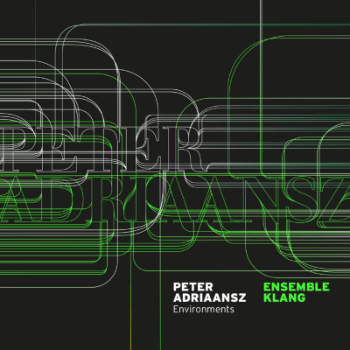No 61/1 Mono (2017-2018)
for amplified ensemble, sinewaves & pre-recorded tracks
Commissioned by: Ensemble Klang XL, with financial support from the Netherlands Fund for the Performing Arts
First Performance: December 20 2018, Festival Musical Utopias, Korzo, Den Haag
Instrumentation: 2 acoustic guitars, 2 synthesizers, bayan, grand piano, live electronics & pre-recorded tracks
Duration: 25’
Special Features: Performance requires sound engineer, amplification for all musicians, click tracks throughout, 6 speaker surround sound setup, live electronics, Ableton sound patch, 6 different guitars and 2 synthesizers
Additional information: Ensemble Klang website
 Listen/Buy: Ensemble Klang on Bandcamp
Listen/Buy: Ensemble Klang on Bandcamp
Info/Program note:
Mono is the first part of Environments. The piece can be performed on its own or as part of this larger cycle. The score consists of a single line (basically a never-repeating rhythmic ostinato) set for 2 restrung ‘unison’ guitars, 2 synthesizers (equipped with banks of modified synthetic guitar samples), Bayan, piano and sine pulse phasing. The musicians all read the same line but with different instructions for each. The piece loosely pursues the idea of ‘Linearity’, as a kind of metaphor for Man’s private, intellectual pursuits. This idea is expressed both through the single-line score as well as through its quasi unison character.
The overall sound of Mono was dictated to a high degree by the resonant qualities of the so-called ‘unison’ guitar: a form of partial restringing where the original thicknesses of the guitar’s strings are retained as much as possible but are tuned up and down to approximate unisons with an overall range of ca. 50 cents. When played continually in sequence the soundboard amplifies the resonance and gradually produces wonderful strings of overtones. This somewhat ‘primitive’ instrument I later found to have some historical precedents, in for example the Korean Geomungo: a member of the Zither family which similarly employs an abundance of primes and octaves in its tuning (four of the total six strings), is equipped with a wealth of wildly different materials for its individual strings (thereby determining ‘character’ more through color than through pitch) and manages to conjure up an abundance of overtones due to the soundboard’s amplification of the harmonically-related open strings. This particular sound world was then translated outward to the rest of the ensemble, extending it to synthetic counterparts (the synthesizers), to the enormous soundboard of the piano and to the microtonal pulse oscillations of the sinewaves, with an independent part for Bayan instructed with no more than to ‘pick up the sounds in the air’. The piece then goes through three phases, each time gradually building up a ‘six string’ situation (where all 6 strings/sounds are in play) before winding the process down again.
The speech track to Mono is taken from the travelogue sections of Robert Pirsig’s Zen and the Art of Motorcycle Maintenance and proceeds in a similar kind of fashion as the book, as a sort of road trip, with the voice articulating a journey as it proceeds. The speech is more-or-less ‘laid over’ the music without any further intentional design. An interesting side-note to the text is that the music was in fact long-written before the text was found. Though the topic of ‘linearity’ was clear from the start, finding a suitable text which had both a sufficient quantity of words (specifically in the form of a described journey) and ditto philosophical content was a journey on its own. Any inference between music and text, though clearly present, is thus in fact entirely circumstantial.. (and, I would like to think, quite in the spirit of Pirsig’s own methods of composition).


